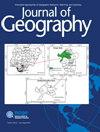Estimating Layer Boundaries of Mixed-layer Tsunami Deposits with a XRF Core Scanner
IF 1.8
3区 地球科学
Q1 GEOGRAPHY
引用次数: 3
Abstract
From the perspective of disaster prevention, it is necessary to clarify the distribution and historical frequency of tsunami deposits. However, tsunami deposits are disturbed by earthquakes and tsunamis. Therefore, it is difficult to identify the layers of deposits. Layers deposited during disturbances are dated and grain-size distribution is measured. Using the results of geochemical data and principal component analyses with detailed elemental distributions, stratigraphic boundaries of past tsunami deposit layers and other layers left in the disturbed deposits are estimated. Samples collected with a geo-slicer consist of a 50-60 cm deep disturbed layer deposited by the Great East Japan Earthquake and underlying sand, peat, and marine deposits. 24 elemental distributions in a core measured using Itrax indicate that the disturbed layer is dominated by heavy metals. Changes in principal component analysis scores infer traces of a layer that could not be visually identified in the disturbed layer. Traces of this layer are consistent with traces that are deposits indicated from the isotopic analysis and the grain size distribution. Therefore, even if it is difficult to identify deposits due to disturbances caused by the tsunami, it may be possible to identify unidentified layers and estimate their thicknesses by compressing their dimensions and clarifying elemental relationships.用XRF岩心扫描仪估算混合层海啸沉积物的层界
从灾害预防的角度出发,有必要明确海啸沉积物的分布和历史频率。然而,海啸沉积物受到地震和海啸的干扰。因此,很难识别沉积层。对扰动期间沉积的地层进行了年代测定,并测量了粒度分布。利用地球化学数据和详细元素分布的主成分分析结果,估计了过去海啸沉积层和扰动沉积层中其他层的地层边界。用地质切片机收集的样本包括由东日本大地震沉积的50-60厘米深的扰动层,以及下面的沙子、泥炭和海洋沉积物。利用Itrax测量的岩心24种元素分布表明,扰动层以重金属为主。主成分分析分数的变化推断出在扰动层中无法直观识别的层的痕迹。该层的痕迹与同位素分析和粒度分布显示的沉积物痕迹一致。因此,即使由于海啸引起的扰动而难以识别沉积物,也有可能通过压缩其尺寸和澄清元素关系来识别未识别的层并估计其厚度。
本文章由计算机程序翻译,如有差异,请以英文原文为准。
求助全文
约1分钟内获得全文
求助全文
来源期刊

Journal of Geography
GEOGRAPHY-
CiteScore
4.90
自引率
6.50%
发文量
12
期刊介绍:
Journal of Geography is the journal of the National Council for Geographic Education. The Journal of Geography provides a forum to present innovative approaches to geography research, teaching, and learning. The Journal publishes articles on the results of research, instructional approaches, and book reviews.
 求助内容:
求助内容: 应助结果提醒方式:
应助结果提醒方式:


